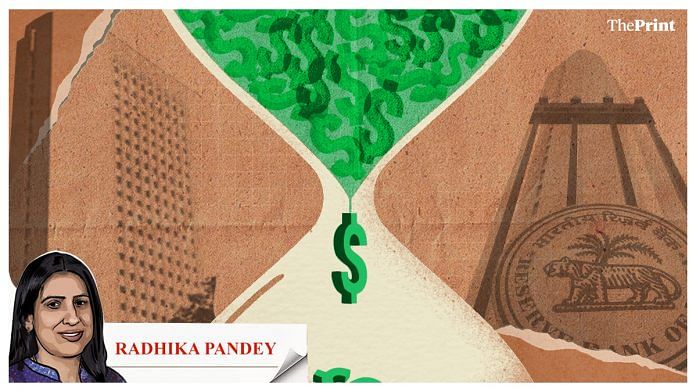Recently, the Reserve Bank of India announced measures to boost inflows of foreign exchange and to stem the slide of the rupee. Till now, the RBI was using its intervention tool to arrest the slide of the rupee. Now, the RBI has turned to easing the capital controls to allow more foreign inflows.
The measures include liberalising the norms for foreign investments in government and corporate bonds, easing the limits for foreign currency borrowings and liberalising norms to help banks attract greater deposits from non-residents.
While some of these measures are in the right direction and could boost sentiments, the immediate impact on the rupee may be limited, given the risk averse environment and global shift towards the safety of the dollar. In addition, the temporary nature of these measures could limit their attractiveness for foreign investors.
Also Read: Weaker rupee, higher inflation — Why US Fed raising rates is more bad news for Indian economy
Measures to boost foreign investment in debt
Traditionally, foreign portfolio investment in government bonds has been subject to multiple controls. In recent years, these controls have been eased. This is a welcome move as foreign investments in rupee denominated bonds do not lead to exchange rate risk for the borrower.
FPI in government bonds is capped at 6 per cent of the outstanding stock of such securities. In addition to the overall cap, investment by FPIs in short-term government and corporate bonds is capped at 30 per cent of the overall investment of a particular FPI.
To liberalise the norms governing FPI flows, in March 2020, the RBI announced a Fully Accessible Route (FAR) that gives unlimited access to FPIs to a select group of government securities, specified by the RBI from time to time. At present, all government securities with 5-year, 10-year and 30-year tenors are eligible securities under the FAR route. After the recent announcement, government bonds of 7-year and 14-year tenors will also be part of the FAR. The intent is to widen the set of securities for which there is no limit on foreign investments.
To augment the flow of foreign investments in government and corporate bonds, the cap of 30 per cent on investment in short-term bonds has been dispensed away till 31 October, 2022.
While these steps are in the right direction, given that the yield on dollar bonds has surged over the last few months, the incentive for foreign investors to invest in Indian bonds may be limited. This is also visible from the data on utilisation of limits. Not more than 28 per cent of the existing limit of investment in government bonds has been utilised by foreign investors.
Frequent changes in rules and temporary relaxations result in uncertainty and limit the interests of investors in such changes. The recent changes need to be accompanied by simplification of the overall regime governing foreign investments in debt.
Liberalisation of foreign currency borrowings
Foreign currency borrowings or External Commercial Borrowings (ECB) by companies are subject to restrictions on the amount that can be borrowed, the maximum interest rate at which the amount can be borrowed, the purpose for which the amount can be borrowed etc.
The RBI has decided to temporarily increase the limit for borrowings from USD 750 million to USD 1.5 billion. The norms governing interest on foreign currency borrowings have also been liberalised. At a time when the rupee is sharply depreciating, greater foreign currency exposure of Indian firms could lead to systemic risk concerns if the borrowings are unhedged from currency fluctuations.
According to the RBI Financial Stability Report, 44 per cent of the foreign currency borrowings are unhedged. Some of these borrowings may have a natural hedge where the borrower’s earnings may also be in foreign currency. The concerning element is that the proportion of hedged foreign currency borrowings has gone down over the last few months.
According to the report on external debt, ECB is the largest component of India’s external debt. Taking advantage of the ultra-low interest rates globally, companies had stepped up their exposure to foreign currency borrowings during the last two years. But now the landscape has changed. Interest rates have been rising and the rupee has depreciated by 6 per cent this year.
While the framework mandates some proportion of borrowings to be hedged, liberalising foreign currency borrowing in an environment of weaker rupee and higher interest rates may not be a prudent move. Moreover, the framework is discretionary and exempts certain classes of borrowers from the hedging requirement.
Liberalisation of non-resident deposits
The Foreign Currency Non-Resident Bank [FCNR(B)] and Non-Resident (External) Rupee deposits have been exempt from the CRR and SLR requirements. The interest ceiling on these deposits have also been dispensed away temporarily. Removal of interest caps will enable banks to offer higher interest rates to non-resident depositors. This may encourage these depositors to look to Indian banks. But given that this relaxation is available till October 31, the impact may be limited.
The rupee is likely to remain under pressure amidst tighter global financial conditions and interest rate hikes by the US Fed. The recent measures to augment the flow of forex are welcome and may help improve foreign inflows in the medium term. However, they need to be followed by more fundamental reforms such as greater certainty, simplification and reducing discretion in the overall regime governing foreign investments.
Radhika Pandey is a consultant at National Institute of Public Finance and Policy.
Views are personal.
Also Read: What the RBI’s sharp interest rate hike portends for the Indian economy



